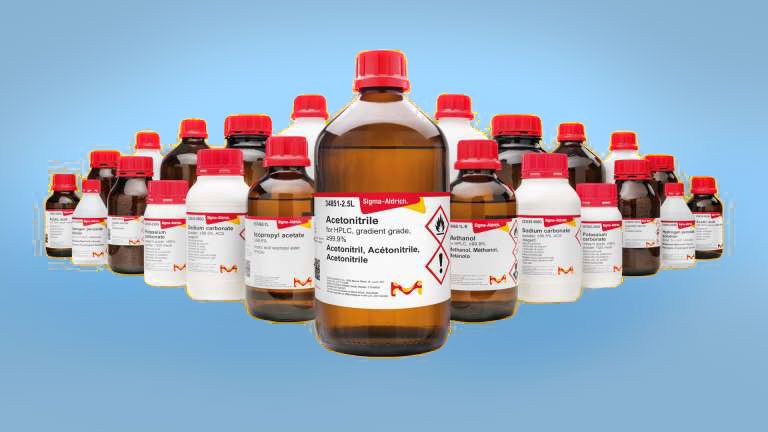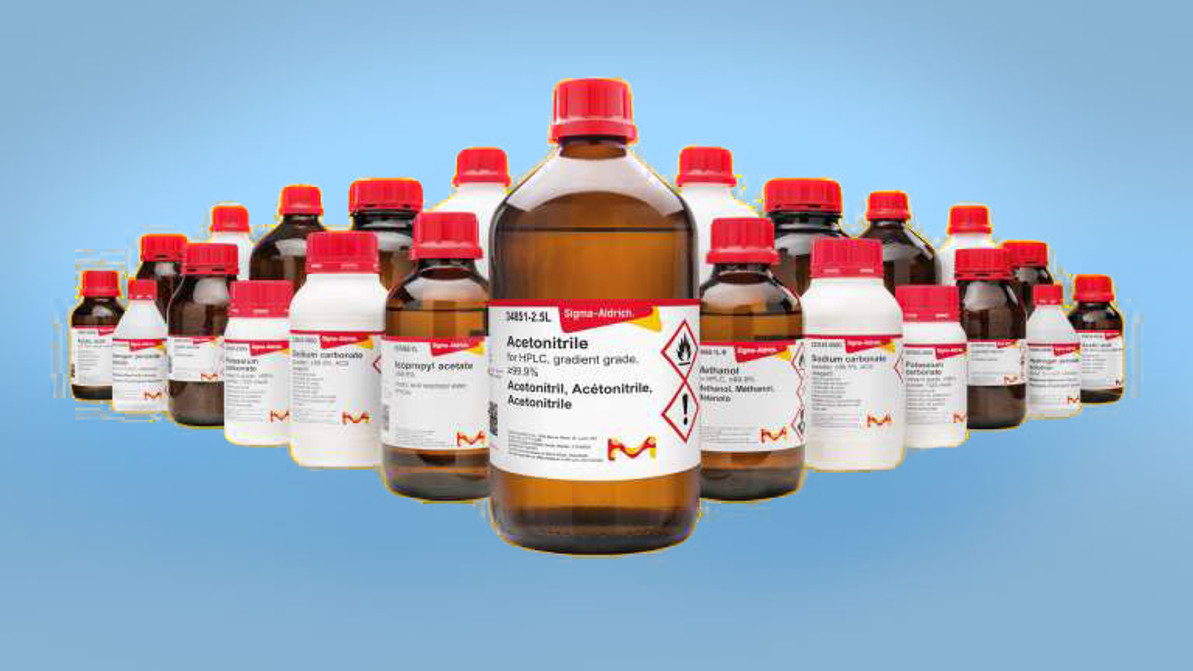A Guide to Solvent Grades
The Basics of Solvent Grades and Background Science
Chemical solvents used in scientific research, analytical testing, and manufacturing play a critical role in the generation of new medicines, products, and analytical procedures used in commerce. Properly identifying the types and grades of solvents that are available and that you need can impact your results in the laboratory or production line.
Using a lower-purity grade of solvent may affect analytical results or impact a product destined for its final use in consumer products, as well contribute to a possible costly mistake. In contrast, using higher-purity grades of solvent are costly, and when not required could result in an unnecessary expense, and not add value to the procedure or product in question.
There are also regulatory issues that may arise in analytical procedures or in products that are generated, and its crucial to have a thorough understanding of the solvents needed, their intrinsic qualities and hazards, grades and final composition from their manufacturing. Taking all these factors will lead to you choosing the right solvent for the right application with as few technical headaches.
At CP Lab Chemicals, we have outlined below the basic grades used in different laboratory procedures and during the generation of food, drug, and nutraceutical and cosmeceutical products. With all the solvent choices out there, purity aand quality assurance designations in some cases are specific to the manufacturer. As different manufacturers have different grade designations related to their brand, this can result in confusion to anyone, including the scientists.
In your work, it is advisable to understand the procedure you are following and attempting, and to use the scientific and safety literature or standard operating procedures as a guide to help you choose the correct solvent grade and purity level to achieve the desired results you need. Failing to do so could be a costly mistake, calling into question analytical results or product compositions, and incurring regulatory or product supply chain issues.
While there are different descriptions of solvent grades in the scientific literature and available on the internet, below are the most common grades used for solvents, from the lowest grade and purity to the highest grades and purity.

Technical Grade
Solvents in this grade are used for industrial or commerce purposes, and they are not to be used for food, drug, or medicinal products. There are no standards presented for this grade, and analytical procedures may be compromised using this grade of solvent. Technical grades are not typically tested for composition or water content, and minimal analytical data may be available for the grade, depending on the manufacturer.
Purified Grade
Used typically in lab-scale and large-scale industrial procedures, this grade may also be found labelled as pure or practical grade. Solvents labelled in this category have no official standards and are not to be used in food, drug, or medicines, or nutraceutical or cosmeceutical formulations often encountered in these products.
Laboratory Grade
This grade is the most commonly encountered and used in educational settings, and with the exact composition and impurity profile unknown, this grade is not to be used for food, drug, or medicinal applications. In analytical chemistry and in academic settings laboratory grades may be used and is a general all-around solvent grade with much less expense.
In contrast, lab-grade solvents would not be appropriate for use in quality-controlled laboratories, those following Good Laboratory Practices (cGLP-certified) or manufacturing facilities using food-grade materials or following Good Manufacturing Practices (cGMP-certified). Lab Grade solvents are acceptable, however, when used in conjunction with clinical histological methods and when used in general clinical laboratory procedures.
NF Grade (National Formulary)
Solvents grades designated NF have stringent specifications for purity that meet or exceed requirements for lesser grades and standards. Furthermore, solvents used in the manufacturing of consumables, nutraceuticals, cosmeceuticals, foods and drugs fall into different classes based on their toxicity:
Class 1-solvents to be avoided-carcinogens including benzene and halogenated solvents
Class 2-solvents to be limited- nitriles, cyclic alkanes, and ethers and certain alcohols
Class 3-solvents with low toxicity thresholds- ketones, alcohols and esters
For a comprehensive description of NF solvent categories, please see the NF Official 2020 announcement, December 1, General Chapter Residual Solvents (467). This monograph also details standard procedures for determining residual solvents in water-soluble and water-insoluble materials by headspace GC analysis, and the solvents and methods encountered in the classes presented above.
USP Grade
This grade of solvent meets or exceeds requirements of the United States Pharmacopeia (USP), an independent agency that sets standards and methods for drugs, active pharmaceutical ingredients (APIs), and formulary ingredients for the food, drug, or medicinal manufacturing industry. The USP is a non-profit, non-governmental agency providing standards and solutions to enhance quality assurance, increase regulatory predictability and assist manufacturers with the distribution of quality medicines, dietary supplements and foodstuffs.
With this grade solvent, the costs rise so ensuring that you actually need this grade is advised. This grade meets the requirements set forth in General Chapter Residual Solvents (467), although topical and dermatological products may be exempt.
Chapter (467) also provides the option of testing of solvent components that can be found in final finished products by GC headspace analysis. As a general rule, and a measure of good science (and a matter of liability), it’s prudent to test the product or article and process in a GLP/GMP environment to prove and substantiate the absence of solvents.
The USP has produced many monographs on the subject of solvent purity, and educational materials provided at USP Education.
Reagent Grade
Solvents in this category grade are typically acceptable for food, drug, or medicinal use, and this grade also is suitable for analytical applications except when determining trace metals, illicit and chain of custody substances and contaminants found in consumer goods and environmental samples.
ACS Grades
Typically, this is the highest grade of solvent that can be used that meets or exceeds standards of purity set by the American Chemical Society, a non-profit and non-governmental agency dedicated to chemical research and chemical manufacturing practices standardization.
ACS grade solvents are acceptable for food, drug, or medicinal use. While this grade is usually equal to Reagent Grade, this grade of solvents are tested to ensure purity, trace metal content, water and residue content, and several other composition parameters including UV absorbance across multiple wavelengths.
ACS Grade is one of the most scrutinized of grades and used in medicine, manufacturing and commerce, and in many instances ACS grade solvents can be used in analytical procedures where stated ACS Grade solvents can be used. ACS standards for solvents requires that their composition is described and supported by certificates of analysis.
Other Solvent Grades Encountered
FCC Grade
These solvents meet the standards and requirements of the Food Chemical Codex, a non-profit, non-governmental regulatory agency cited in the U.S. Code of Federal Regulations and recognized by food regulatory agencies all over the world.
GenAR Grade
Solvents and reagents with designated purities for genetic and biopharmaceutical research. These solvents meet the requirements of 1995 USP 23, and may be tested for bacterial contamination and cell endotoxins (LAL, limulus amebocyte lysate) when appropriate. Enzyme free grades are also used in specialized ribonucleic acid research (RNA) and in molecular biology and genetic recombination experiments.
Analytical Grades of Solvent
Solvents used in analytical chemistry methods and procedures are typically of higher purity and have Actual Lot Analysis data as an indication and a guarantee of purity. The determinations of purity are based on technical publications and analytical methods and standard test procedures.
Spectrophotometric Grade (Spec-Grade)
These solvents are of the highest purity (and most expensive) solvents used in spectrophotometric analysis, high-pressure liquid chromatography, and for trace compound, metal, and contaminant detection. Spec grade solvents are multiply-distilled, only in contact with ultra-fine borosilicate glasses to lower possible ionic contaminants, and the ultra-violet (or other detecting wavelengths) impurities removed by chemical and absorption processes. Solvents in this grade are usually 97-99% + pure, and the UV absorbances determined across the UV spectrum of light.
HPLC Grade
Solvents in this category are of high-purity, specifically tested for UV absorbance, and are passed through 4.0 micron or below polycarbonate filters to remove particles that can damage HPLC columns and detectors. HPLC Grade solvents are low acidity, low alkalinity liquids with a low residue and dissolved solids count. These solvents are desirable for reproducibility during HPLC analysis.
GC Grade
Such solvents are tested to insure they are organic compound and contaminant-free, absent of pesticides and are extensively used in Environmental Protection Agency (EPA) established applications and methods, such as EPA Method 525.2, used for the detection of organic compounds found in drinking water.
Given the legal ramifications of environmental and product testing, this is a preferred grade in the analytical laboratory. It’s noted that some EPA methods specify the exact manufacturer and provider of solvents, and as the supply chains evolve or all together disappear it’s possible to use other solvent suppliers with similar specifications in their products to the EPA methods.
LC/MS Grade
This grade of analytical solvent is typically encountered in the environmental lab or pharmacokinetic/pharmacodynamic lab, and wherever sensitive and reproducible measurements are needed. Typically, solvents in this category possess the same spectroscopic grade materials used in trace compound and contaminant analysis, (HPLC and GC Grades) with the added filtration of the solvent through 0.2 micron polycarbonate membranes to remove residual particles.
his filtration step ensures testing reproducibility, accuracy, and to protect the mass spectrometer from residue build-up and costly instrument ion-source damage. This grade of solvent is one of the most expensive encountered in the analytical laboratory, and encountered when using LC/MS and LC/MS/MS and high-resolution Time-of Flight instruments.
LC/MS grade is also suitable for UHPLC-MS (Ultrahigh-pressure (or performance) liquid chromatography, UHPLC and UHPLC-UV spectroscopy where sensitivity is needed. Solvents in this category possess the lowest levels of trace metal impurities possible to minimize metal ion-analyte adduct formation during analysis.
This grade of solvent is analyzed and the certificates of analysis provided to assure compliant standardization and for determining the lowest detection limits and confidence in analyses in all currently practiced mass spectroscopy modes.
Solvent Manufacturers
Every solvent manufacturer has added their own branding and product descriptions to their products, and these systems are now encountered when purchasing solvents for either laboratory, analytical or manufacturing and commercial use.
We can help you navigate chemical solvents, their grades, and chemical hazards just “Ask A Chemist” and we would delighted to help you.
Recent Posts
-
Disinfecting Surfaces in the Era of Covid and EPA Registered Commercial Disinfectants and Viricides
The disinfection of surfaces at home, in public spaces, and in hospitals and clinics needs to be a …15th Jan 2023 -
Working with Inorganic Acids in the Laboratory: A Practical Guide
Working with Inorganic Acids in the LaboratoryAcids are of great importance in the laboratory and ar …4th Jan 2023 -
The Top 12 Drinking Water Contaminants
1.Lead- from older plumbing systems pre-1986, when lead pipes, solder, and components were banned. …14th Dec 2022

